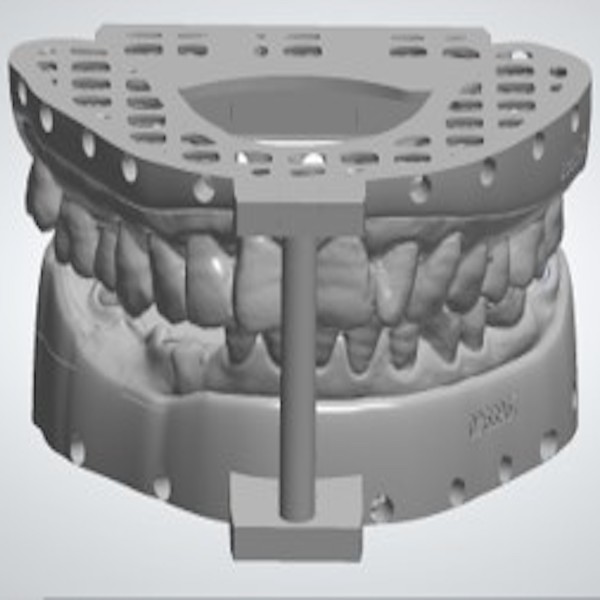This article explores a unilateral distal extension edentulous case restored by multiple implants with a digital workflow. Dr. Chen from Hangzhou Stomatological Hospital uses SHINING 3D’s Aoralscan 3.
Case information and treatment plan
We diagnosed the patient with missing dentition after intraoral and radiological examination.
Treatment plan: Remove #43-#47 defective restoration and #43, #45, Make implant restoration at the same time.
Implant operation: #44 with Straumann BL NC3.3*8mm implant; #46, #47 with Straumann BL RC4.8*8mm implant, torsion 35Ncm, healing cap was placed and soft tissue flap was sutured in opposite position. CBCT showed that the implant could be implanted after operation, and the final repair was carried out a few months later after a transitional period.
Restoration process for unilateral distal extension edentulous patient
Gingival shaping was first completed after several months of gingival surgery. The patient obtained a good gingival contour and profile. After the gingival recovery was complete, the final implant restoration could be made by digital impression workflow.


Gingival information collection: The patient’s intraoral gingival profile data was scanned by SHINING 3D Aoralscan 3 intraoral scanner. Good quality gingival profile data is certainly important to the design and manufacture of a restoration.
Tips: This kind of free-end mucosal data can be collected more quickly with a mouth opener.


Scan body information collection
We used the Aoralscan 3 intraoral scanner to create the scan body information in the patient’s mouth.
Tips: When collecting this kind of data, dry the saliva on the scan body. Place the scan body feature on the buccal or lingual side to make it easier to collect.
The Aoralscan 3D intraoral scanner successfully collected the patient’s intraoral information.
Data acquisition completed
We subsequently sent the data to the lab technician through SHINING 3D’s Dental Cloud platform.


Model editor
Then, we imported the data into 3shape software for model editing.



Tips: Choose the corresponding data format on SHINING 3D’s Dental Cloud platform according to the design software you prefer to use.

Finally, we made the fitting and the adjustment of the restoration on the printed model and gingiva.


Dental restoration fabrication
After that, we milled the final restoration by CAD/CAM.

Try-in
Then, we put the final abutment in the patient’s mouth.

Fix the final dental restoration
Lastly, final abutment and final dental restoration sitting:
X-ray examination showed that the position of the restoration was accurate, the approximal contact was good, and the occlusion was stable.

Case summary
In summary, this unilateral distal extension edentulous implant case adopted a fully digital workflow from impression to restoration.
Using the Aoralscan 3 intraoral scanner enabled the collection of accurate 3D data of the patient’s mouth in only a few minutes. On one hand, this improves the efficiency of the diagnosis and chair-side treatment process. On the other, it also greatly reduces problems such as time-consuming, tedious working procedures, silicone rubber deformation, or transfer movement which leads to inaccurate data.
With the cloud transmission function and digital processing flow, it not only further ensures the accuracy of the implant model and restoration, but also greatly shortens the production time.
In conclusion, the treatment is more efficient and comfortable all while patients are more satisfied.
SHINING 3D conducted this unilateral distal extension edentulous case in cooperation with the West Hospital of Hangzhou Stomatological Hospital. Thanks to Dr. Chen for his support and trust.
 ENG
ENG




















